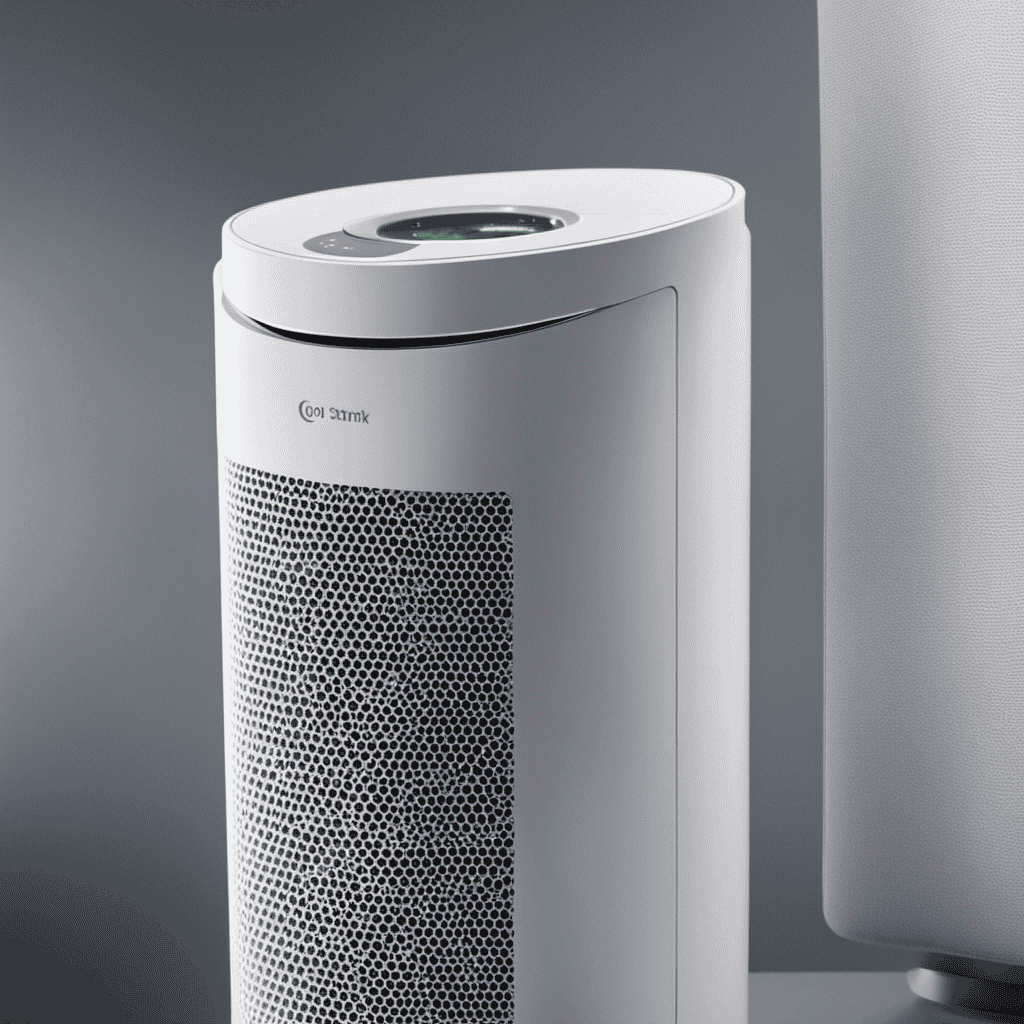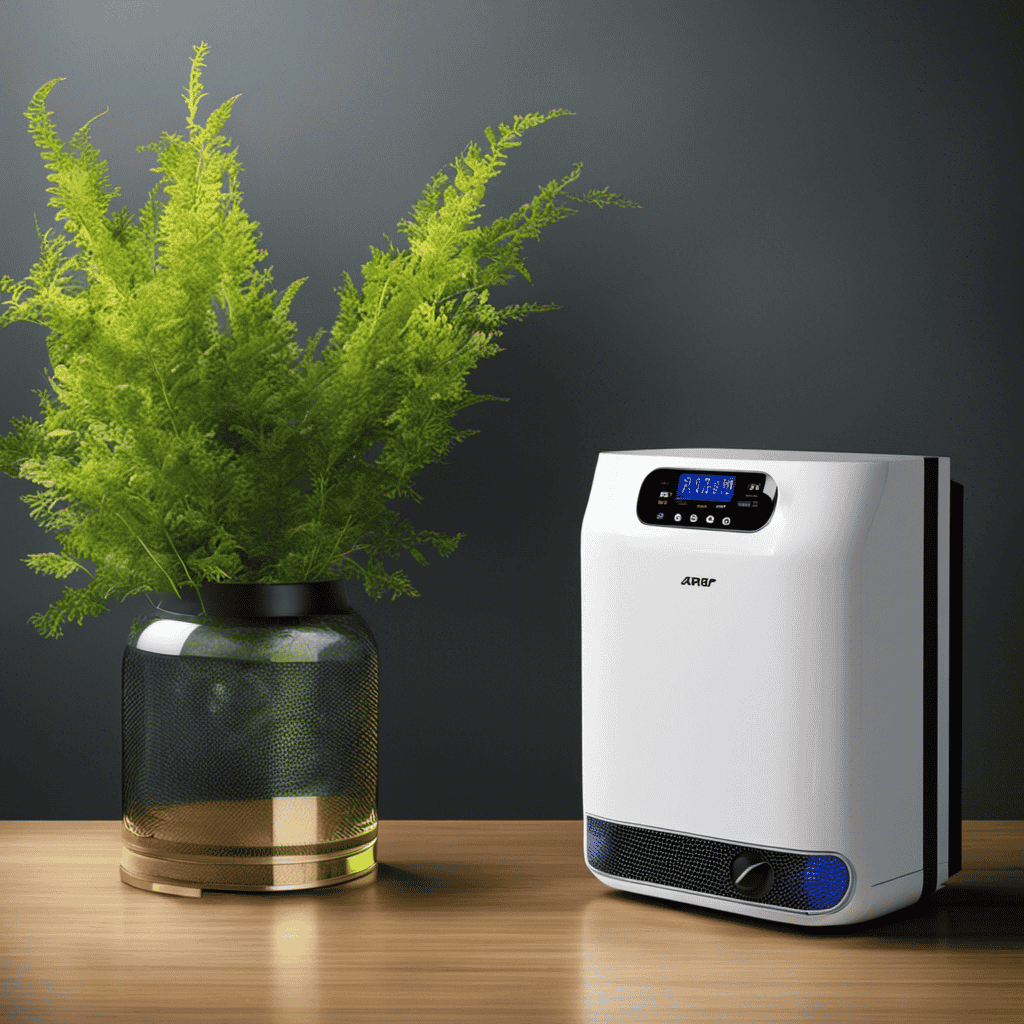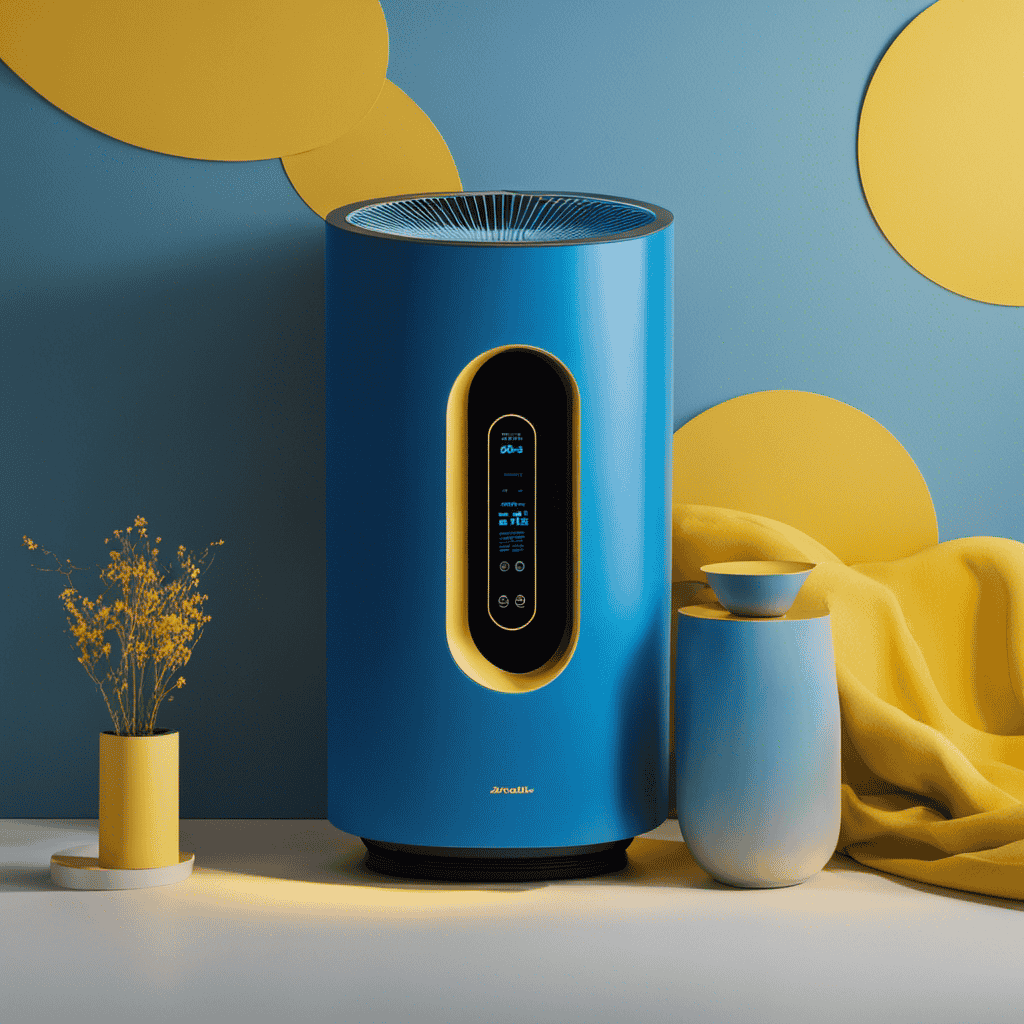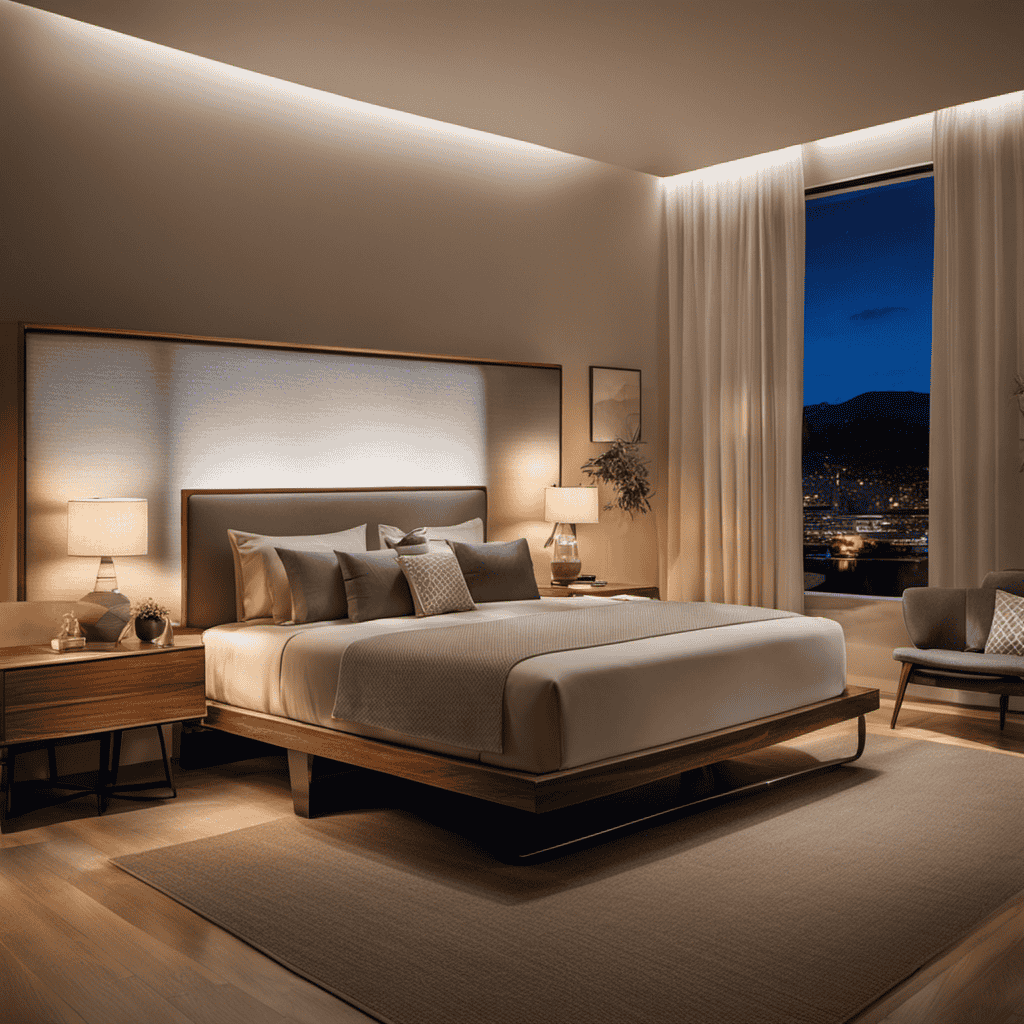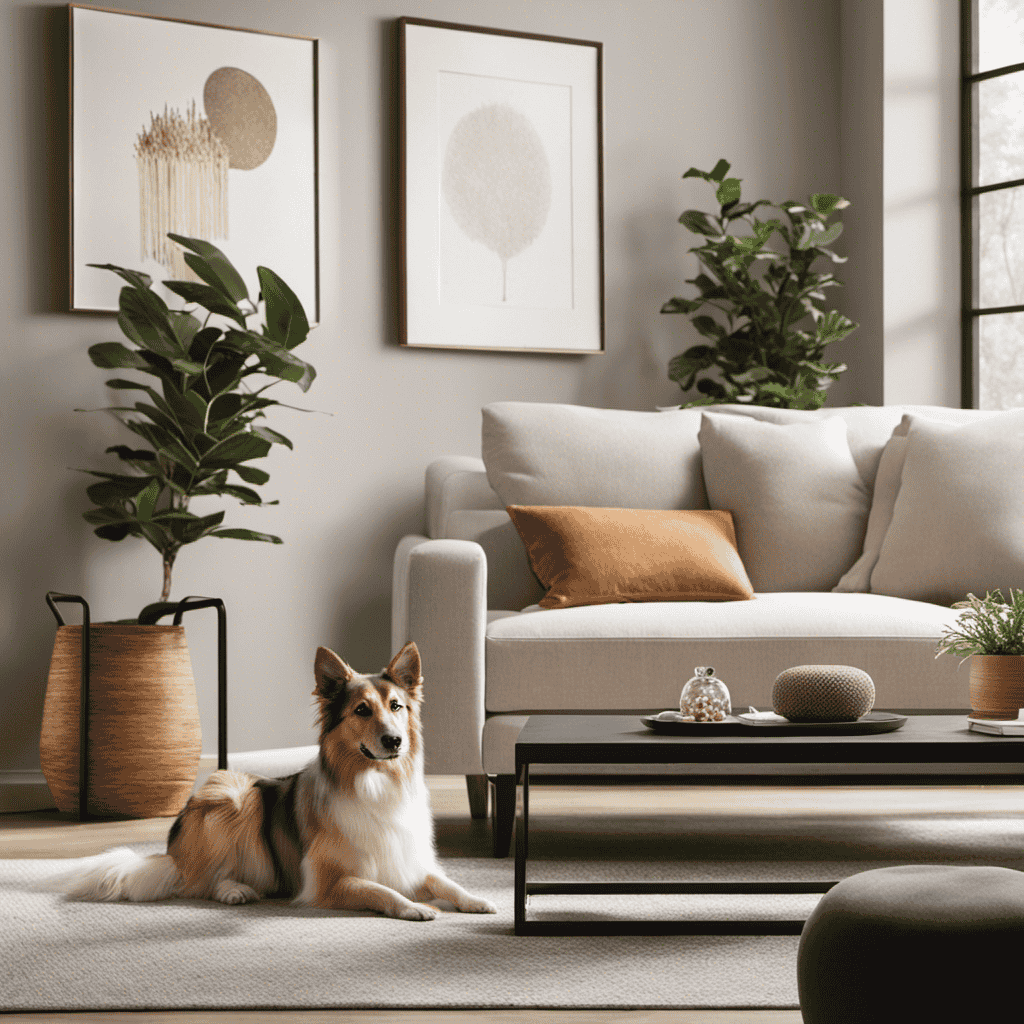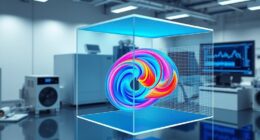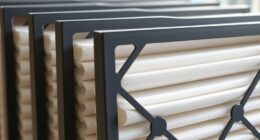I am a specialist in air purification, and I can attest that air purifier filters play a crucial role in maintaining clean indoor air. These filters work tirelessly to capture pollutants, allergens, and tiny particles, helping us breathe fresh and healthy air.
But just like any hero, these filters have their limits. So, how often should they be changed? In this article, we delve into the factors that affect filter lifespan, manufacturer recommendations, and tips for extending their longevity.
Get ready to unlock the secrets to pristine air quality.
Key Takeaways
- Regularly cleaning and replacing filters is crucial for maximizing filter lifespan and effectiveness in capturing pollutants.
- Follow manufacturer recommendations for optimal performance and clean air, as different filter types have varying lifespans.
- Filter lifespan depends on filter quality, air quality, and usage frequency. Understanding these factors helps determine the best time to replace filters.
- The frequency of filter replacement depends on usage and air quality, with HEPA filters generally lasting longer than activated carbon filters.
Factors Affecting Filter Lifespan
You should consider several factors that can affect how long your air purifier filters will last. Optimal filter maintenance is crucial for maximizing the lifespan of your filters. Regularly cleaning and replacing filters is essential to ensure their effectiveness in capturing and removing airborne pollutants. Neglecting filter maintenance can lead to decreased airflow, reduced filtration efficiency, and increased strain on the air purifier’s motor.
One of the common filter problems that can affect their lifespan is clogging. Filters can become clogged with dust, pet dander, pollen, and other particles over time. This accumulation restricts airflow and reduces the filter’s ability to capture pollutants effectively. Regularly vacuuming or washing your filters can help prevent clogging and prolong their lifespan.
Another factor to consider is the quality of the filters. Higher quality filters are generally more durable and efficient. They can trap smaller particles and have a longer lifespan compared to lower quality filters. Investing in filters with a high MERV (Minimum Efficiency Reporting Value) rating can ensure optimal filtration performance and longer-lasting filters.
Lastly, the environment in which the air purifier is used can also impact filter lifespan. If you live in an area with high levels of pollution or if you have pets, you may need to clean or replace your filters more frequently. Similarly, if you frequently keep windows or doors open, allowing more outside air to enter, your filters may become dirtier faster.
Manufacturer Recommendations
According to the manufacturer, it’s important to follow their recommendations when it comes to changing the filters. To ensure optimal performance of your air purifier and maintain clean and healthy air in your environment, here are the key factors to consider for filter lifespan and optimal filter replacement:
-
Usage: The frequency of filter changes depends on how often the air purifier is in use. If you use it for extended periods or in environments with high levels of pollutants, filters may need to be replaced more frequently.
-
Air Quality: The quality of air in your surroundings plays a significant role in the lifespan of your filters. If you live in an area with high pollution levels or have pets or smokers in your home, the filters may accumulate more pollutants and require more frequent replacement.
-
Filter Type: Different filter types have varying lifespans. HEPA filters, for instance, generally need replacement every 6-12 months, while carbon filters may be replaced every 3-6 months. The manufacturer’s recommendations for your specific air purifier model should be followed.
By understanding these filter lifespan factors and following the manufacturer’s recommendations, you can ensure that your air purifier operates at its best.
Now, let’s explore the next section about filter type and quality to further enhance our knowledge.
Filter Type and Quality
When it comes to optimal filter replacement for air purifiers, there are a few factors to consider.
The lifespan of a filter depends on various factors such as the quality of the filter, the air quality in the environment, and the usage frequency of the purifier.
Understanding these factors can help determine the best time to replace the filter and ensure the air purifier continues to function effectively.
Optimal Filter Replacement
To ensure optimal performance, it’s best to replace air purifier filters regularly. Proper maintenance is crucial for keeping your air purifier running efficiently and effectively. Here are three key reasons why regular filter replacement is essential:
-
Improved Air Quality: Over time, air filters become clogged with dust, allergens, and other pollutants. By replacing the filters regularly, you can maintain cleaner air in your home and reduce the risk of respiratory issues.
-
Extended Lifespan: When filters are dirty, the air purifier has to work harder to clean the air. This can lead to increased wear and tear on the unit, potentially shortening its lifespan. Regular filter replacement helps preserve the longevity of your air purifier.
-
Cost-Effective: While filter replacement does incur some cost, it is more cost-effective in the long run. A clogged filter can decrease the efficiency of the air purifier, resulting in higher energy consumption. By replacing filters regularly, you can save on energy bills and avoid costly repairs.
Filter Lifespan Factors
Regularly replacing air purifier filters helps extend the lifespan of the unit by reducing wear and tear caused by dirty filters.
The frequency of filter replacement depends on various factors, such as the type of air purifier, the quality of the filter, and the air quality in your environment.
Generally, it is recommended to replace the filters every 3 to 6 months for optimal performance. However, in highly polluted areas or if you have pets or allergies, more frequent replacements may be necessary.
When considering the cost of filter replacement, it is important to factor in not just the upfront cost of the filters, but also the long-term savings in terms of improved air quality and reduced maintenance.
Investing in high-quality filters may initially cost more, but they tend to last longer and provide better filtration, resulting in cost savings over time.
Frequency of Air Purifier Use
When it comes to optimal filter replacement and extending filter lifespan, there are a few key points to consider.
First, it’s important to understand the recommended frequency for replacing air purifier filters based on the manufacturer’s guidelines and the specific model you own.
Additionally, there are certain steps you can take to prolong the lifespan of your filters. This includes regularly cleaning pre-filters and using the air purifier in an environment with minimal dust and pollutants.
Optimal Filter Replacement
The recommended timeframe for changing air purifier filters is typically every 3-6 months. Following manufacturer recommendations is crucial for maintaining optimal indoor air quality levels.
Here are three important factors to consider when determining the frequency of filter replacement:
-
Usage: The more frequently an air purifier is used, the more often the filter will need to be changed. If you run your purifier continuously or in high-traffic areas, it may be necessary to replace the filter every three months.
-
Air Quality: If you live in an area with poor air quality or have specific indoor air concerns such as pet dander or allergens, you may need to replace the filter more frequently to ensure effective filtration.
-
Filter Type: Different filter types have varying lifespans. HEPA filters, for example, generally last longer than activated carbon filters. Checking the manufacturer’s recommendations for your specific filter type is essential.
Extending Filter Lifespan
In order to optimize the lifespan of air purifier filters, it is essential to implement strategies that increase filter efficiency and reduce the need for frequent filter maintenance. By doing so, we can not only save time and effort but also extend the overall lifespan of the filter, ultimately enhancing the performance of the air purifier.
One effective way to increase filter efficiency is to regularly clean the pre-filter. This preliminary filter traps larger particles, such as dust and pet hair, before they reach the main filter. Cleaning the pre-filter on a weekly basis prevents these larger particles from clogging the main filter, allowing it to function more effectively.
Additionally, ensuring that the air purifier is properly sized for the room it is operating in can significantly reduce filter maintenance. An undersized unit will have to work harder, resulting in a higher accumulation of pollutants and ultimately requiring more frequent filter replacements.
Indoor Air Quality Levels
You should regularly monitor your indoor air quality levels to ensure a healthy living environment. Indoor air pollution can have detrimental effects on your health, so it’s important to stay informed and take necessary measures to maintain clean air in your home. Here are three key reasons why monitoring indoor air quality is crucial:
-
Health effects: Poor indoor air quality can lead to various health problems, including respiratory issues, allergies, and even long-term complications such as asthma. By monitoring air quality, you can identify potential pollutants and take steps to reduce their presence, ultimately safeguarding your health and the well-being of your loved ones.
-
Identifying sources: Monitoring air quality allows you to pinpoint specific sources of indoor air pollution. Whether it’s mold, pet dander, or volatile organic compounds (VOCs) emitted by household products, knowing the source helps you address the problem effectively. By eliminating or minimizing these sources, you can significantly improve the air quality in your home.
-
Prevention and control: Regular monitoring enables you to detect any sudden changes or spikes in pollution levels. With this knowledge, you can take immediate action to prevent further pollution and implement measures to control and improve the air quality. This proactive approach helps create a healthier living environment and reduces the risk of any associated health issues.
Dust and Pollen Levels in the Area
As someone who suffers from allergies, I understand the importance of having an air purifier with filters that can effectively capture seasonal allergens such as pollen and dust.
The changing seasons can have a significant impact on the air quality, and it is crucial to have filters that are specifically designed to handle these allergens.
For allergy sufferers, having filters that can efficiently remove these particles from the air is essential for maintaining a clean and healthy indoor environment.
Seasonal Impact on Filters
The seasonal impact can affect how often air purifier filters need to be changed. Understanding the seasonal filter maintenance and having a proper filter replacement schedule is crucial for optimal air purification performance. Here are three key factors to consider:
-
Pollen season: During the spring and summer months, pollen levels tend to spike, especially in areas with high vegetation. This can lead to increased clogging of the air purifier filters, requiring more frequent replacements.
-
Dust accumulation: In dry seasons or areas with high dust levels, filters can become clogged more quickly. Regularly checking and cleaning the filters can help prolong their lifespan.
-
Allergen seasons: Some areas experience specific allergen seasons, such as mold spores in the fall or pet dander in the winter. Adjusting the filter replacement schedule accordingly can ensure effective filtration during peak allergen periods.
Allergy Sufferers’ Needs
Allergy sufferers may benefit from adjusting their filter replacement schedule to coincide with peak allergen seasons. As someone who understands the challenges of managing allergies, I can attest to the importance of proper filter maintenance. By replacing filters more frequently during high pollen or mold seasons, individuals can better manage their allergies and minimize symptoms. Research has shown that using clean filters can significantly reduce the presence of allergens in the air, providing relief to those affected. To emphasize this point, consider the following table:
| Filter Replacement Frequency | Peak Allergen Season |
|---|---|
| Every 30 days | Spring |
| Every 60 days | Summer |
| Every 90 days | Fall |
| Every 120 days | Winter |
Pet Hair and Dander
Regularly changing air purifier filters can help reduce pet hair and dander in the home. As someone who suffers from pet allergies, I understand the importance of maintaining a clean and allergen-free environment. Pet shedding is a common issue for many pet owners, and it can exacerbate allergies and respiratory problems.
By using an air purifier with a high-efficiency particulate air (HEPA) filter, you can effectively remove pet hair and dander from the air, reducing the risk of allergic reactions. Here are three reasons why regularly changing air purifier filters is crucial for managing pet allergies and controlling pet shedding:
-
Improved Air Quality: HEPA filters are designed to capture tiny particles, including pet hair and dander, ensuring cleaner air for you and your family.
-
Reduced Allergic Reactions: By removing pet allergens from the air, you can minimize the risk of allergy symptoms such as sneezing, coughing, and itchy eyes.
-
Control Pet Shedding: Regularly changing the air purifier filter can help control pet shedding by trapping loose hairs before they settle on surfaces in your home.
Smoking and Odors
To effectively eliminate smoke and odors in your home, it’s important to consider using an air purifier with specialized filters. Air purifiers are highly effective at removing smoke particles and neutralizing unpleasant odors, providing numerous health benefits for you and your family.
The effectiveness of an air purifier in eliminating smoke and odors depends on the type of filters it uses. Activated carbon filters are particularly effective at removing smoke particles and odors. These filters contain a large surface area of activated carbon, which has the ability to trap and adsorb volatile organic compounds (VOCs) and other chemical pollutants found in smoke and odors. By trapping these harmful particles, activated carbon filters can significantly improve the air quality in your home.
In addition to removing smoke particles and odors, air purifiers with specialized filters can also provide health benefits. Smoke and odors can have detrimental effects on respiratory health, aggravating conditions such as allergies and asthma. By effectively eliminating these pollutants, air purifiers can help reduce symptoms and improve overall respiratory function.
While air purifiers are highly effective at removing smoke and odors, they can also provide relief for those suffering from allergies and asthma.
Allergies and Asthma
Transitioning into the topic of allergies and asthma, it’s worth noting that air purifiers with specialized filters can provide relief for those suffering from respiratory conditions. Allergy prevention is a key aspect of managing allergies and asthma, and air purifiers can play a significant role in creating a healthier indoor environment. Here are three reasons why air purifiers are effective in reducing allergens and improving air quality:
-
Filter Efficiency: Air purifiers equipped with HEPA (High-Efficiency Particulate Air) filters are designed to capture particles as small as 0.3 microns in size. This includes common allergens like dust mites, pollen, pet dander, and mold spores. By effectively trapping these particles, air purifiers can help minimize allergy triggers in the air.
-
Odor Reduction: Some air purifiers also feature activated carbon filters, which are excellent at absorbing odors caused by allergens or chemical irritants. This can be particularly beneficial for individuals with sensitivities to strong smells or those with asthma triggered by certain odors.
-
Air Circulation: Air purifiers work by continuously circulating the air in a room, filtering out pollutants in the process. This helps maintain a clean and fresh indoor environment, reducing the chances of encountering allergens and asthma triggers.
Signs of a Clogged Filter
If you notice reduced airflow or increased dust in your home, it might be a sign that your air purifier’s filter is clogged and needs attention. Filter maintenance is an important aspect of ensuring the efficiency and effectiveness of your air purifier.
Over time, the filter collects dirt, dust, and other particles from the air, and if not properly maintained, it can become clogged, reducing the airflow and compromising the air purification process. Regularly checking and cleaning or replacing the filter is crucial to maintain optimal performance.
Fortunately, many air purifiers come equipped with filter replacement indicators. These indicators are designed to notify you when the filter needs to be changed. Some indicators are based on time, while others use sensors to measure the level of particulate accumulation in the filter. These advanced systems can accurately determine the filter’s condition and alert you when it reaches its maximum capacity.
It is important to follow the manufacturer’s instructions for filter maintenance and replacement. Generally, it is recommended to clean or replace the filter every 3 to 6 months, depending on usage and the level of pollutants in your environment. However, if you live in a highly polluted area or have pets, you may need to clean or replace the filter more frequently.
Regular filter maintenance is essential to ensure that your air purifier continues to provide clean and healthy air in your home. By paying attention to signs of reduced airflow or increased dust and utilizing the filter replacement indicators, you can effectively maintain your air purifier’s filter and enjoy improved indoor air quality.
Cleaning Vs. Replacing Filters
In my previous discussion on the signs of a clogged filter, I highlighted the importance of recognizing when your air purifier’s filter needs attention. Now, let’s delve into the cleaning methods and filter maintenance practices that can help extend the lifespan of your filters.
-
Regular cleaning: Depending on the type of filter in your air purifier, regular cleaning can be a viable option. Some filters, like pre-filters and washable filters, can be cleaned and reused. Cleaning methods may include vacuuming, rinsing with water, or using a brush to remove dust and debris. However, it is crucial to follow the manufacturer’s instructions to ensure proper cleaning techniques.
-
Replacement schedule: Despite regular cleaning, filters will eventually lose their effectiveness. It is essential to establish a replacement schedule based on the manufacturer’s recommendations. This schedule typically ranges from every three to six months, depending on factors like air quality, usage, and filter type.
-
Professional servicing: For more complex filters, such as activated carbon or HEPA filters, professional servicing may be necessary. These filters may not be designed for cleaning and require replacement when clogged or saturated.
Tips for Extending Filter Lifespan
To extend the lifespan of your filters, it’s important to follow the manufacturer’s recommendations for cleaning and replacement. Proper maintenance techniques can help maintain and even improve filter efficiency, ensuring that your air purifier continues to effectively remove pollutants from the air.
One key technique for extending filter lifespan is regular cleaning. Depending on the type of filter, this may involve simply vacuuming or rinsing the filter or using a specialized cleaning solution. Regular cleaning helps remove accumulated dust and debris, preventing clogging and maintaining optimal airflow.
In addition to cleaning, another important maintenance technique is timely filter replacement. Filters have a limited lifespan and become less efficient over time. It is recommended to replace filters as per the manufacturer’s guidelines, which typically range from every three to six months. Neglecting to replace filters can lead to reduced filtration performance, allowing more pollutants to circulate in the air.
Furthermore, it’s crucial to keep an eye on the air quality in your environment. If you notice a significant decrease in air purifier efficiency, despite regular cleaning and filter replacement, it may be necessary to upgrade to a higher efficiency filter or consider a more powerful air purifier.
Frequently Asked Questions
Are Air Purifier Filters Interchangeable Between Different Brands and Models?
Air purifier filters are not generally interchangeable between different brands and models. Each brand and model is designed with specific filter dimensions and specifications to fit their respective units. Using filters that are not recommended for your specific air purifier can lead to decreased efficiency and may even damage the unit.
It is important to use the filters recommended by the manufacturer to ensure optimal performance and maximum benefits in terms of air purification.
Can I Wash and Reuse Air Purifier Filters?
Reusing and washing air purifier filters is not recommended. Air purifier filters are designed to capture and trap particles, pollutants, and allergens from the air. Over time, these filters become clogged and less effective.
Washing the filters may damage the delicate fibers and reduce their ability to filter the air properly. It is best to follow the manufacturer’s guidelines and replace the filters regularly to maintain optimal air quality in your home.
How Do I Know if My Air Purifier Is Effectively Removing Pollutants From the Air?
When it comes to knowing if my air purifier is effectively removing pollutants from the air, accuracy is key. To measure air quality accurately, I rely on sensors that detect particulate matter and monitor the levels in real-time.
Additionally, I optimize my air purifier’s performance by ensuring proper placement, regularly cleaning the unit, and keeping doors and windows closed.
These tips help me breathe cleaner air and stay healthier.
Is It Necessary to Run My Air Purifier Continuously or Can I Turn It off When I Leave the Room?
It’s important to consider whether it’s better to leave your air purifier on all the time or turn it off when you leave the room.
Running the purifier continuously ensures that the air in the room is constantly filtered, providing a consistent level of clean air.
However, if you’re concerned about energy consumption, you can turn it off when you’re not in the room.
Keep in mind that air purifiers take time to clean the air, so it’s best to give it enough time to work effectively.
Can Air Purifier Filters Remove Viruses and Bacteria From the Air?
Air purifier filters can indeed remove viruses and bacteria from the air, improving indoor air quality and reducing the risk of respiratory illnesses. However, it is important to note that the effectiveness of air purifier filters in removing these microorganisms can vary depending on the type of filter and the specific model of the air purifier.
Regularly changing the air purifier filters is crucial to maintain their efficiency and prolong their lifespan, ensuring optimal performance and maximum benefits.
What Factors Determine the Frequency of Air Purifier Filter Changes?
The frequency of air purifier filter changes depends on several factors such as the size of the room, the level of air pollution, and the type of filter used. Regular maintenance and monitoring of air quality are crucial to determine the optimal timing for air purifier filter changes.
Conclusion
In conclusion, it’s crucial to regularly change air purifier filters. This ensures optimal performance and clean indoor air. The lifespan of filters can be influenced by various factors. These include manufacturer recommendations, filter type, and frequency of use. By monitoring indoor air quality levels and considering personal health conditions like allergies and asthma, you can determine when it’s time to replace a clogged filter. Just like a well-oiled machine, a fresh filter keeps your air purifier running smoothly. It’s like a gentle breeze on a hot summer day, bringing relief.
